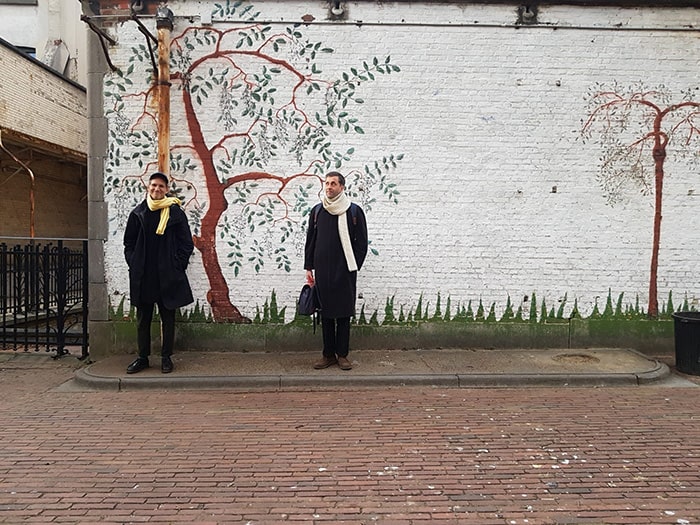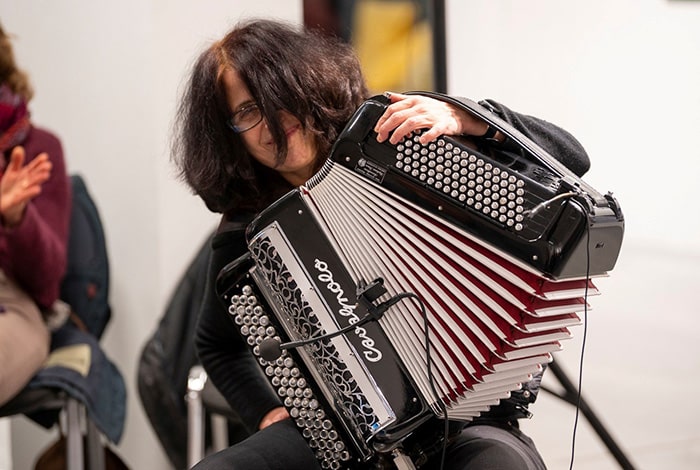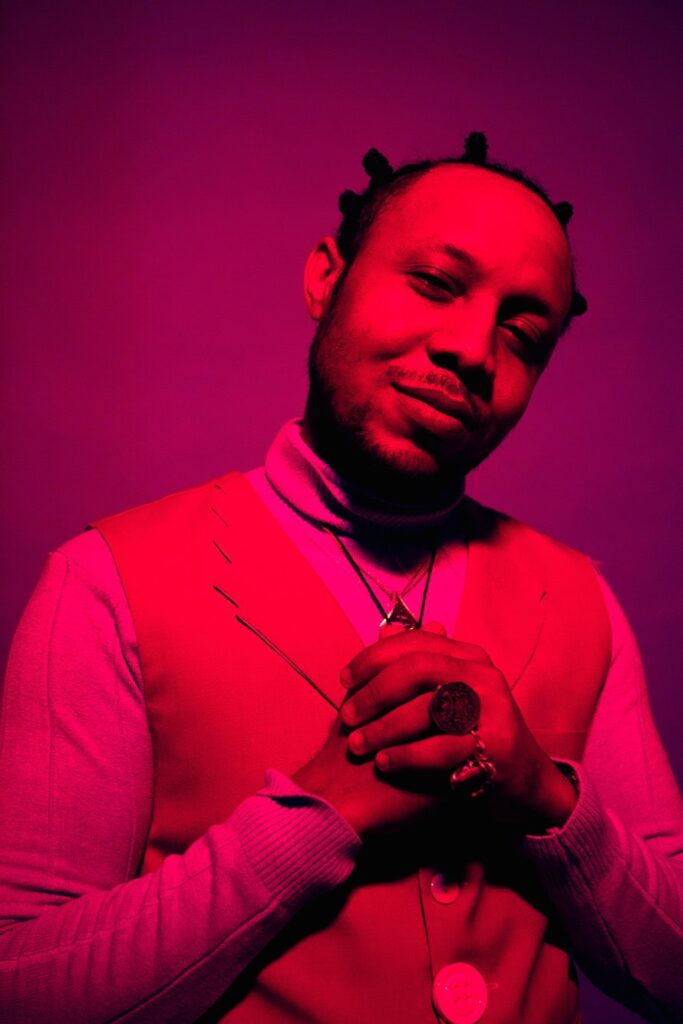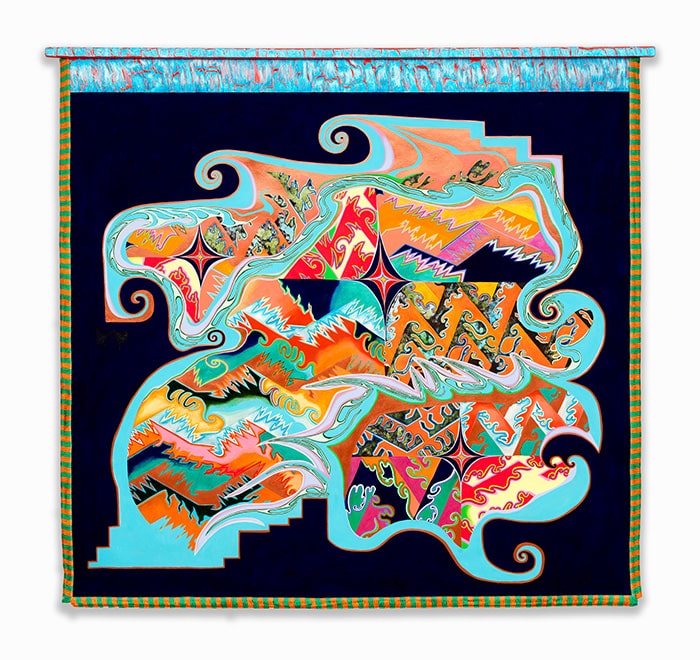Kunsthalle Münster presents ton not. not ton, a concert, a performance and an exhibition from 06.05. to 04.06.2023. Ton not. not ton is dedicated to the sound of things, letting it appear in acoustic interventions, objects in space and one’s own imagination. It is about the interpenetration of visual art with music. The second edition focuses on textures, frequencies, structures, colours, patterns and movement. At the same time, the score or choreography is considered as a form-giving and visual instrument. ton not. not ton deals with the way sound articulates movement, spaces, dynamics and above all time. Just like the musical contributions, rhythm is inherent in the works of visual art, giving them a performativity of their own.
Image above: Lisa Alvarado, Vibrating Cartography: Nepantla, 2021, acrylic, ink, gouache, canvas, burlap, fringe, polyester, wood, 228.6 x 207 cm / Acrylic, ink, gouache, canvas, burlap, fringe, polyester, wood, 228.6 x 207 cm. Courtesy of the artist, The Modern Institute / Toby Webster Ltd, Glasgow and / and Bridget Donahue, New York. Photo: Tom Van Eynde
Channa Horwitz (1932-2013) worked on a drawing system since the early 1960s. Derived from the format of standard American millimetre paper, the artist represents time by means of graphic units and movement in time as associated colour schemes and uses them to design structures that translate temporal-spatial relationships into drawings. Most of her drawings are based on the numerical sequence one to eight and a colour code assigned to each digit. She declines the number sequences in ever new variations, developing them into highly complex structures. Her works resemble graphic notations that want to be deciphered. For Horwitz, the deliberate restriction to the simplest rules did not mean a restriction in the name of creative self-censorship; rather, it was an attempt to find an aesthetic language so pure and untouched by the meanings of the world that it can reproduce the passage of time with approximate precision. “If I wanted to experience freedom,” Horwitz said in a 2005 conversation with Chris Kraus, “I needed to reduce all of my choices down to the least amount.”

Since the late 1960s, Horwitz has also used a series of drawings, which she captures under the title Sonakinatographien – a compound of the Greek words for “sound”, “movement” and “notation” – as choreographic source material for performances. Her pieces push the genre boundaries between dance, performance and visual art. A total of three works from the Sonakinatography complex are on view: Sonakinatography XI Variation II (1981), Sonakinatography Composition XXII Number 2 (1981) and Sonakinatography Composition XXIII (2002). From 1968 until shortly before her death, the artist worked on countless variations of the 23 different compositions in the series. Each of these drawings can be interpreted musically or choreographically and realised as a concert, performance or spatial installation. During the opening of the exhibition, an interpretation of the works can be heard by the sound artist and accordionist Anja Kreysing. She uses her computerised accordion to play the scores.
Lisa Alvarado (b. 1982) is a visual artist and musician. Her artistic practice is inspired by a textile tradition and public murals in America, her family’s experiences as Mexican Americans in the border region, the Chicano movement and her musical performances with the band Natural Information Society, in which she plays the harmonium. The colours she uses in her paintings are reminiscent of modernist paintings, while the geometric compositions are reminiscent of Mexican textiles. Her works hover between categories. Some of the graphic stepped shapes, prismatic compositions, meandering or zigzag patterns and glyph-like forms seem inspired by Mayan textiles; other of the painted surfaces recall desert scrub, coral reefs and aerial views. Alvarado began producing the works as wearable sets for Natural Information Society in 2010. They allow the audience to also be visually drawn into the dynamics of the sonic action. When you look at her canvases, you feel like you can see more the longer you look at them. Lines begin to slip, patterns swarm, sharp angles shift, colours light up, shapes seem to be in motion.

The first of Samuel Beckett’s (1906-1989) minimalist television plays appeared in 1980 under the title Quadrat (Square), which he realised for the Süddeutscher Rundfunk. It operates with the serial play of a movement pattern of four actors. The interplay of space and time is demonstrated here in the strictest way. Made both recognisable and unrecognisable by coloured hoods, they perform a relentless closed-circuit drama: once they have entered the square, they are condemned to walk the six steps of the square’s longitudinal and diagonal lines monotonously and synchronously, accompanied by various drum rhythms: Actor:in 1: AC, CB, BA, AD, DB, BC, CD, DA; Actor 2: BA, AD, DB, BC, CD, DA, AC, CB; Actor 3: CD, DA, AC, CB, BA, AD, DB, BC; Actor 4: DB, BC, CD, DA, AC, CB, BA, AD. The centre of the square, marked with a dot, is always bypassed on the left. The mathematical precision of the choreography is made possible by exact timing, an automation of the sequences, an almost machine-like state of the actors. The variation of the choreography is limited to the number of actors and the resulting changing colour constellations.
Musica Mosaica focuses on composition according to predefined principles and constraints based on a strictly approximate understanding of musical fundamentals such as rhythms, intervals and notes. After years of playing mainly improvised music in various projects (Buffle, Humus, Saule), Brussels-based Xavier García Bardón and Emmanuel Gonay now transfer their intuitive approach to the field of writing. In search of flatness and perspective, they formulate rules but allow themselves to circumvent them. They collect sounds and images from different sources and apply different protocols to create a divergent perspective informed by film editing and geometry.

Gavsborg has been producing music with the Equiknoxx Music label for over ten years. The Jamaican ensemble of the same name pairs classic dub and sound system techniques with genre-unusual broken beats and genre-unusual eclectic samples; you hear crackling bags or bleating horns, quacking ducks or squawking birds of prey. His versatility and unconventional musical approach has enabled Gavsborg to collaborate with a variety of artists and labels such as Mavado, Aidonia, Dirty Projectors, Palmistry, Addis Pablo, De La Ghetto, Busy Signal, Spice, Missy Elliott, DDS, Swing Ting and Domino Records. For the opening of ton not. not ton, Gavsborg will play a solo live set based on his experimental EP Jamaican Drum Machine. This does not refer to a specific machine or instrument, but is rather about the feeling that Jamaica gives him.
Curators inside:
Nguyen Phuong-Dan studied Cultural Anthropology at the University of Hamburg and Visual Communication at the Hamburg University of Fine Arts (HfbK). He works on a project basis in various fields. Among other things, he produced the photo book Die Deutschen Vietnamesen (The German Vietnamese) in collaboration with Stefan Canham and the staged documentary film Ein Haus in Ninh Hoa (A House in Ninh Hoa) together with Philip Widmann. In cooperation with the Kunstverein Harburger Bahnhof in Hamburg, he initiated the project One Hundred People Say Umbrella (2015), which dealt with auditory publications in the context of visual art. He was also involved in curating the events Immersion (Gropius Bau, Berlin), Music From High Wires (Kampnagel, Hamburg), Intonal Festival (Inkonst, Malmö) and Possible Musics (Palais de la Porte Dorée, Paris), among others. Under the name Phuong-Dan, he is active internationally as a DJ and has been hosting his own club series at the Golden Pudel Club in Hamburg since 2003. In early 2021, he founded dispari – a label and platform for auditory publications and performances at changing venues.
Merle Radtke is an art historian and works as a curator and author. She has worked as a curator for the Hamburger Kunsthalle and the Kunstmuseum Stuttgart, among others. From 2015 to 2017, she was a member of the research training group Aesthetics of the Virtual at the Hamburg University of Fine Arts (HfbK). As a scholarship holder of the Villa Kamogawa/Goethe-Institut Kyoto, a research stay of several months followed. She regularly publishes texts on contemporary art and culture. Her work focuses on the practice and theory of the internet, (post-) digital art practice, feminism and the examination of simulation. She has been the director of Kunsthalle Münster since July 2018.
Cooperation: A collaboration between Kunsthalle Münster and dispari – a label and platform for auditory publications and performances at changing locations, initiated and run by Nguyen Phuong-Dan.
With Lisa Alvarado, Samuel Beckett, Gavsborg, Channa Horwitz, Anja Kreysing and Musica Mosaica, the second edition of ton not. not ton also brings together contributions by visual artists and musicians, bringing together people who move at the boundaries of their respective fields. The first issue of ton not. not ton took place in autumn 2021 with contributions by Florian Bräunlich, Gerrit Frohne-Brinkmann, Sven-Åke Johansson, Museum of No Art, Tomoko Sauvage, Saskia Senge, Gesa Troch and Hannah Weinberger.
WHERE?
Kunsthalle Münster
Hafenweg 28
48155 Münster
WHEN?
Exhibition days:
Saturday, 06. May – Sunday, 04. June 2023
Opening hours:
Tue – Sun 12 – 18 h






